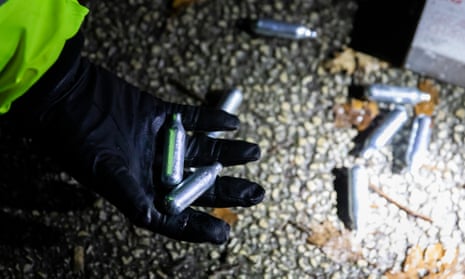Young people who use nitrous oxide, commonly known as “laughing gas”, to get high are running huge risks with their health, including paranoia, breathing problems and even death, nurses have warned.
Inhaling nitrous oxide is so dangerous that ministers need to launch a high-profile campaign to alert users to the potentially disastrous consequences, frontline NHS nurses say.
The drug, also known as “noz” and “hippy crack”, is very popular with teenagers and young adults, including clubbers and those attending music festivals. It is the same substance that is given to women during childbirth and patients undergoing dental treatment to control pain. Those using it illicitly often breathe it in after it has been transferred from silver vials into balloons.
It is the second most commonly used drug among 16- to 24-year-olds in England after cannabis. Half a million of them have used it in the last year – one in 11 of that age group. Many more males than females that age turn to it in their search for a euphoric high, the latest Home Office figures show.
But taking it can lead to a range of health problems such as burns, a dangerously increased heart rate, swelling on the brain, nerve damage and anaemia, as well as serious psychological problems, according to delegates at the Royal College of Nursing’s annual conference in Liverpool on Tuesday.
They will demand action to highlight the drug’s dangers during a debate on what they say is “a significant lack of understanding of the impact that nitrous oxide has upon the health and wellbeing of individuals using it”, especially too little awareness among users of its pitfalls.
“Despite the increasing use of nitrous oxide, particularly among younger people, far too few people know about the risks. It might give a short-term high but the long-term damage is no laughing matter,” said Catherine Gamble, the RCN’s professional lead for mental health nursing.
On average five people a year die after inhaling the gas, and it caused 25 fatalities between 2010 and 2016, Office of National Statistics figures show.
A&E doctors say they are seeing more people in need of immediate medical help after using it.
“The effects of inhaling nitrous oxide gas can include headaches, nausea, dizziness, unconsciousness, collapse and consequent injury,” said Dr Chris Moulton, vice-president of the Royal College of Emergency Medicine.
“When administered by a healthcare professional it is an extremely safe drug, but recreational use may be dangerous. The delivery method can be especially dangerous because the gas is under such high pressure that direct inhalation may cause damage to the throat and lungs.”
Outlawing the sale of nitrous oxide in 2016 has failed to stem the black-market trade, and nurses are seeing the consequences, Gamble said.
Roz Gittins, director of pharmacy at the drug and alcohol charity Addaction, said: “When taken recreationally it can cause euphoria and help people to feel more relaxed, sometimes becoming giggly or hallucinating. [But] breathing problems may occur when a large amount of the gas is inhaled over a short amount of time or in an enclosed space.”
Steve Rolles, senior policy analyst at the drug reform charity Transform, said use of the drug had increased steadily over the past 15 years.
“Nitrous oxide is particularly hard to prohibit, given its widespread uses in catering, medicine, and motoring – and its rising use demonstrates that attempts to ban it have failed.
“Given this, a harm-reduction approach is the only realistic way to reduce risk: educating people on how to use it more moderately and safely, and how to avoid risks of injury from fainting, asphyxiation, or the B12 depletion related to heavy use,” he added.









